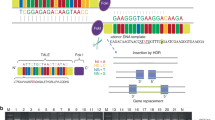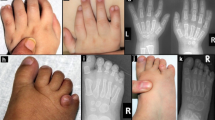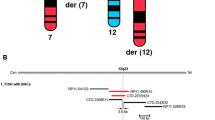Abstract
Indian hedgehog (Ihh) signaling is a major determinant of various processes during embryonic development and has a pivotal role in embryonic skeletal development. A specific spatial and temporal expression of Ihh within the developing limb buds is essential for accurate digit outgrowth and correct digit number. Although missense mutations in IHH cause brachydactyly type A1, small tandem duplications involving the IHH locus have recently been described in patients with mild syndactyly and craniosynostosis. In contrast, a ∼600-kb deletion 5′ of IHH in the doublefoot mouse mutant (Dbf) leads to severe polydactyly without craniosynostosis, but with craniofacial dysmorphism. We now present a patient resembling acrocallosal syndrome (ACS) with extensive polysyndactyly of the hands and feet, craniofacial abnormalities including macrocephaly, agenesis of the corpus callosum, dysplastic and low-set ears, severe hypertelorism and profound psychomotor delay. Single-nucleotide polymorphism (SNP) array copy number analysis identified a ∼900-kb duplication of the IHH locus, which was confirmed by an independent quantitative method. A fetus from a second pregnancy of the mother by a different spouse showed similar craniofacial and limb malformations and the same duplication of the IHH-locus. We defined the exact breakpoints and showed that the duplications are identical tandem duplications in both sibs. No copy number changes were observed in the healthy mother. To our knowledge, this is the first report of a human phenotype similar to the Dbf mutant and strikingly overlapping with ACS that is caused by a copy number variation involving the IHH locus on chromosome 2q35.
Similar content being viewed by others
Log in or create a free account to read this content
Gain free access to this article, as well as selected content from this journal and more on nature.com
or
References
Zeller R, López-Rios J, Zuniga A : Vertebrate limb development: moving towards integrative analysis of organogenesis. Nat Rev Genet 2009; 10: 845–858.
Karp SJ, Schipani E, St-Jaques B, Hunzelmann J, Kronenberg H, McMahon AP : Indian hedgehog coordinates endochondral bone growth and morphogenesis via parathyroid hormone related-protein-dependent and –independent pathways. Development 2000; 127: 543–548.
Long F, Chung UI, Ohba S, McMahon J, Kronenberg HM, McMahon AP : Ihh signaling is directly required for the osteoblast lineage in the enchondral skeleton. Development 2004; 131: 1309–1328.
Zhou J, Meng J, Guo S et al: IHH and FGF8 coregulate elongation of digit primordia. Biochem Biophys Res Commun 2007; 363: 513–518.
Gao B, Guo J, She C et al: Mutations in IHH, encoding Indian hedgehog, cause brachydactyly Type A-1. Nat Genet 2001; 28: 386–388.
Wieczorek D, Pawlik B, Li Y et al: A specific mutation in the distant sonic hedgehog (SHH) cis-regulator (ZRS) causes Werner mesomelic syndrome (WNS) while complete ZRS duplications underlie Haas type polysyndactyly and preaxial polydactyly (PPD) with or without triphalangeal thumb. Hum Mutat 2010; 31: 81–89.
Lettice LA, Hill AE, Devenney RS, Hill RE : Point mutations in a distant sonic hedgehog cis-regulator generate a variable regulatory output responsible for preaxial polydactyly. Hum Mol Genet 2008; 17: 978–985.
Litingtung Y, Dahn RD, Li Y, Fallon JF, Chiang C : Shh and Gli3 are dispensable for limb skeleton formation but regulate digit number and identity. Nature 2002; 418: 979–983.
Babbs C, Furniss D, Morris-Kay GM, Wilkie AO : Polydactyly in the mouse mutant Doublefoot involves altered Gli3 processing and is caused by a large deletion in cis to indian hedgehog. Mech Dev 2008; 125: 517–526.
Klopocki E, Lohan S, Brancati F et al: Copy-number variations involving the IHH locus are associated with syndactyly and craniosynostosis. Am J Hum Genet 2011; 88: 70–75.
Zody MC, Jiang Z, Fung HC et al: Evolutionary toggling of the MAPT 17q21.31 inversion region. Nat Genet 2008; 40: 1076–1083.
Kirchoff M, Bisgaard AM, Duno M, Hansen FJ, Schwartz M : A 17q21.31 microduplication, reciprocal to the newly described 17q21.31 microdeletion, in a girl with severe psychomotor delay and dysmorphic craniofacial features. Eur J Med Genet 2007; 50: 256–263.
McClintock TS, Glasser CE, Bose SC, Bergmann DA : Tissue expression pattern identify mouse cilia genes. Physiol genomics 2008; 32: 198–206.
Huber C, Munnich A, Cormier-Daire V : The 3M syndrome. Best Pract Res Clin Endrocrinol Metab 2011; 25: 143–151.
Itsumikawa T, Kitagawa H, Mizuguchi S et al: Nematode chondroitin polymerizing factor showing cell-/organ-specific expression is indispensable for chondroitin synthesis and embryonic cell division. J Biol Chem 2004; 279: 53755–53761.
Dutrannoy V, Demuth I, Baumann U et al: Clinical variability and novel mutations in the NHEJ1 gene in patients with a Nijmegen breakage syndrome-like phenotype. Hum Mutat 2010; 31: 1059–1068.
Cantagrel V, Lossi AM, Lisgo S et al: Truncation of NHEJ1 in a patient with polymicrogyria. Hum Mutat 2007; 28: 356–364.
Hilton MJ, Tu X, Cook J, Hu H, Long F : Ihh controls cartilage development by antagonizing GLI3, but requires additional effectors to regulate osteoblast and vascular development. Development 2005; 132: 4339–4351.
Kmita M, Fraudeau N, Hérault Y, Duboule D : Serial deletions and duplications suggest a mechanism for the collinearity of Hoxd genes in limbs. Nature 2002; 420: 445–450.
Putoux A, Thomas S, Coene KL et al: KIF7 mutations cause fetal hydrolethalus and acrocallosal syndromes. Nat Genet 2011; 43: 601–606.
Courtens W, Vamos E, Cristophe C, Schinzel A : Acrocallosal syndrome in an Algerian boy born ro consanguineous parents: review of the literature and further delineation of the syndrome. Am J Med Genet 1997; 69: 17–22.
Johnston JJ, Olivos-Glander I, Turner J et al: Clinical and molecular delineation of the Greig cephalosyndactyly contiguous gene deletion syndrome and its distinction from acrocallosal syndrome. Am J Med Genet A 2003; 123A: 236–242.
Vortkamp A, Gessler M, Grzeschik KH : GLI3 zinc-finger gene interrupted by translocations in Greig syndrome families. Nature 1991; 352: 539–540.
Wild A, Kalff-Suske M, Vortkamp A, Bornholdt D, König R, Grzeschik KH : Point mutations in human GLI3 cause Greig syndrome. Hum Mol Genet 1997; 6: 1979–1984.
Gollop TR, Fontes LR : The Greig cephalosyndactyly syndrome: report of a family and review of the literature. Am J Med Genet 1985; 22: 59–68.
Ingham PW, McMahon AP : Hedgehog signaling: Kif7 is not that fishy after all. Curr Biol 2009; 19: R729.731.
Acknowledgements
We thank the family members for participating in this study, Dr M Kalff-Suske for molecular genetic testing of GLI3 in our patient and Karin Boss for critically reading the manuscript. This work was supported by the German Federal Ministry of Education and Research (BMBF) by grant number 01GM0880 (SKELNET) and 01GM0801 (E-RARE network CRANIRARE) to BW and the Turkish Council of Science (TUBİTAK) by grant number 108S418 (E-RARE network CRANIRARE partner 4) to HK and OU.
Author information
Authors and Affiliations
Corresponding author
Ethics declarations
Competing interests
The authors declare no conflict of interest.
Additional information
Supplementary Information accompanies the paper on European Journal of Human Genetics website
Supplementary information
Rights and permissions
About this article
Cite this article
Yuksel-Apak, M., Bögershausen, N., Pawlik, B. et al. A large duplication involving the IHH locus mimics acrocallosal syndrome. Eur J Hum Genet 20, 639–644 (2012). https://doi.org/10.1038/ejhg.2011.250
Received:
Revised:
Accepted:
Published:
Issue date:
DOI: https://doi.org/10.1038/ejhg.2011.250
Keywords
This article is cited by
-
Deletion in 2q35 excluding the IHH gene leads to fetal severe limb anomalies and suggests a disruption of chromatin architecture
European Journal of Human Genetics (2019)
-
DB2: a probabilistic approach for accurate detection of tandem duplication breakpoints using paired-end reads
BMC Genomics (2014)



